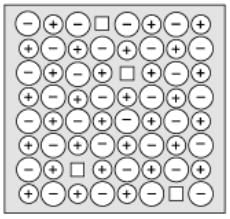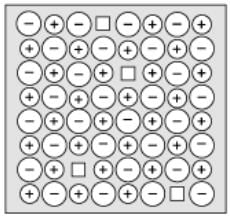Case Based Questions Test: The Solid State (Old NCERT) - NEET MCQ
5 Questions MCQ Test Physical Chemistry for NEET - Case Based Questions Test: The Solid State (Old NCERT)
Read the passage given below and answer the following questions:
In ideally ionic structures, the coordination numbers of the ions are determined by electrostatic considerations. Cations surround themselves with as many anions as possible and vice versa. This maximizes the attractions between neighbouring ions of opposite charge and hence maximizes the lattice energy of the crystal. This requirement led to the formulation of the radius ratio rule for ionic structures in which the ions and the structure adopted for a particular compound depend on the relative sizes of the ions. Thus, for the stable ionic crystalline structures, there is definite radius ratio limit for a cation to fit perfectly in the lattice of anions, called radius ratio rule. This depends upon the ratio of radii of two types of ions, r+/r–.
This ratio for coordination numbers 3, 4, 6 and 8 are respectively 0.155 – 0.225, 0.225 -0.414, 0.414 -0.732 and 0.732 – 1.000. The coordination number of ionic solids also depends upon temperature and pressure. On applying high pressure, coordination number increases. On the other hand, on applying high temperature, it decreases.
Q. If the radius of Nation is 95 pm and that of Cl– ion is 181 pm, the coordination number of Na+ ion is
In ideally ionic structures, the coordination numbers of the ions are determined by electrostatic considerations. Cations surround themselves with as many anions as possible and vice versa. This maximizes the attractions between neighbouring ions of opposite charge and hence maximizes the lattice energy of the crystal. This requirement led to the formulation of the radius ratio rule for ionic structures in which the ions and the structure adopted for a particular compound depend on the relative sizes of the ions. Thus, for the stable ionic crystalline structures, there is definite radius ratio limit for a cation to fit perfectly in the lattice of anions, called radius ratio rule. This depends upon the ratio of radii of two types of ions, r+/r–.
This ratio for coordination numbers 3, 4, 6 and 8 are respectively 0.155 – 0.225, 0.225 -0.414, 0.414 -0.732 and 0.732 – 1.000. The coordination number of ionic solids also depends upon temperature and pressure. On applying high pressure, coordination number increases. On the other hand, on applying high temperature, it decreases.
Q. If the radius of Nation is 95 pm and that of Cl– ion is 181 pm, the coordination number of Na+ ion is
Study the diagram given below and answer the following questions:

In these questions, a statement of Assertion followed by a statement of Reason is given. Choose the correct answer out of the following choices.
Assertion (A): LiCl Crystal is pink.
Reason (R): Pink colour of LiCl crystal is due to excess Lithium.

Assertion (A): LiCl Crystal is pink.
Reason (R): Pink colour of LiCl crystal is due to excess Lithium.
| 1 Crore+ students have signed up on EduRev. Have you? Download the App |
Read the passage given below and answer the following questions:
In ideally ionic structures, the coordination numbers of the ions are determined by electrostatic considerations. Cations surround themselves with as many anions as possible and vice versa. This maximizes the attractions between neighbouring ions of opposite charge and hence maximizes the lattice energy of the crystal. This requirement led to the formulation of the radius ratio rule for ionic structures in which the ions and the structure adopted for a particular compound depend on the relative sizes of the ions. Thus, for the stable ionic crystalline structures, there is definite radius ratio limit for a cation to fit perfectly in the lattice of anions, called radius ratio rule. This depends upon the ratio of radii of two types of ions, r+/r–.
This ratio for coordination numbers 3, 4, 6 and 8 are respectively 0.155 – 0.225, 0.225 -0.414, 0.414 -0.732 and 0.732 – 1.000. The coordination number of ionic solids also depends upon temperature and pressure. On applying high pressure, coordination number increases. On the other hand, on applying high temperature, it decreases.
Q. Which is not the correct statement for ionic solids in which positive and negative ions are held by strong electrostatic attractive forces?
In ideally ionic structures, the coordination numbers of the ions are determined by electrostatic considerations. Cations surround themselves with as many anions as possible and vice versa. This maximizes the attractions between neighbouring ions of opposite charge and hence maximizes the lattice energy of the crystal. This requirement led to the formulation of the radius ratio rule for ionic structures in which the ions and the structure adopted for a particular compound depend on the relative sizes of the ions. Thus, for the stable ionic crystalline structures, there is definite radius ratio limit for a cation to fit perfectly in the lattice of anions, called radius ratio rule. This depends upon the ratio of radii of two types of ions, r+/r–.
This ratio for coordination numbers 3, 4, 6 and 8 are respectively 0.155 – 0.225, 0.225 -0.414, 0.414 -0.732 and 0.732 – 1.000. The coordination number of ionic solids also depends upon temperature and pressure. On applying high pressure, coordination number increases. On the other hand, on applying high temperature, it decreases.
Q. Which is not the correct statement for ionic solids in which positive and negative ions are held by strong electrostatic attractive forces?
Study the diagram given below and answer the following questions:

In these questions, a statement of Assertion followed by a statement of Reason is given. Choose the correct answer out of the following choices.
Assertion (A): The crystal lattice density increases due to the defect shown in the diagram.
Reason (R): Tetrahedral voids are surrounded by 4 constituent particles.
Read the passage given below and answer the following questions:
In ideally ionic structures, the coordination numbers of the ions are determined by electrostatic considerations. Cations surround themselves with as many anions as possible and vice versa. This maximizes the attractions between neighbouring ions of opposite charge and hence maximizes the lattice energy of the crystal. This requirement led to the formulation of the radius ratio rule for ionic structures in which the ions and the structure adopted for a particular compound depend on the relative sizes of the ions. Thus, for the stable ionic crystalline structures, there is definite radius ratio limit for a cation to fit perfectly in the lattice of anions, called radius ratio rule. This depends upon the ratio of radii of two types of ions, r+/r–.
This ratio for coordination numbers 3, 4, 6 and 8 are respectively 0.155 – 0.225, 0.225 -0.414, 0.414 -0.732 and 0.732 – 1.000. The coordination number of ionic solids also depends upon temperature and pressure. On applying high pressure, coordination number increases. On the other hand, on applying high temperature, it decreases.
Q. If the pressure of CsCl is increased, then its coordination number will
|
117 videos|225 docs|239 tests
|
|
117 videos|225 docs|239 tests
|

















